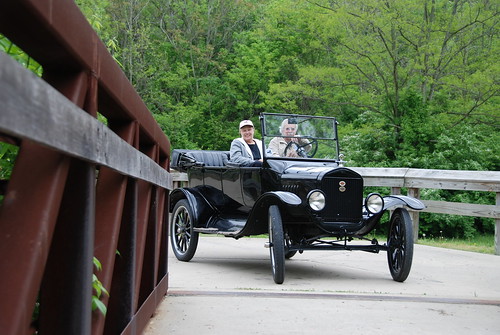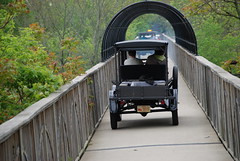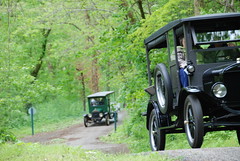Up to 150 Model T cars per day to drive on Wayne County Greenway
The first Ford Model T rolled off of the production line in September 1908. The Model T Ford Club of America will hold a 100th birthday bash in Richmond, Indiana from July 21 to July 26. 900 Model T's from around the world will visit, with up to 40,000 visitors expected this weekend for the century celebration.Of the Model T, Henry Ford famously said, "It will be low in price that no man making a good salary will be unable to own one - and enjoy with his family the blessing of hours of pleasure in God's great open spaces."

Model T on Cardinal Greenway, Wayne County, Indiana.
Just as the original Model T's took over roads that were originally paved for bicyclists, the century celebration Model Ts will ironically cruise the only bicycle / pedestrian path in Richmond, the Whitewater Gorge - Cardinal Greenway in Wayne County on tours offered all next week. Up to 150 cars will be allowed on the Greenway on each of Monday, Wednesday, Thursday, Friday and Saturday. Says the Model T tour brochure:
Nature Lover’s Tour of Wayne CountyPhoto Credit: Diana Pappin.
This tour will be a real treat for the Model T nature lovers! Thanks to the generosity of the City of Richmond and the Parks & Recreation Department, Model Ts are being permitted to drive the Whitewater Gorge-Cardinal Greenway trail. Normally only open to hikers and bikers, this will be a real treat to drive, as well as a test of your driving skills!
It is a dramatic, beautiful trail through deep woods with great views of the river gorge and the towering G Street bridge. There are quite a few steep hills and 9 bridges.
Thistlethwaite Falls is one remnant of an ancient waterfall which has been migrating upstream for thousands of years, deepening the Gorge as it went. The Niagara Gorge was formed in a similar manner by the backward movement of Niagara Falls. A dozen Potawatami Indiana teepees were seen near Thistlethwaite Falls by one of the first white settlers. Later, a mill was built nearby and the falls became a popular picnic spot for early residents of Richmond. About twenty acres of flood plain and wooded hillside owned by Friends United Meeting are being managed as a bird sanctuary here. The Gorge presents favorable nesting conditions for about fifty species of native birds - from house wren to green heron. How many will you see? How many more will you hear? North and south of where Bridge Avenue crosses the river, the bedrock of limestone and shale is exposed in nearly vertical cliffs. These layers of rock ere deposited by an ancient sea about 450 million years ago and contain one of the world's best fossil records of the primitive animals that lived in that period. So valuable are the examples of rock strata exposed here and elsewhere in the Gorge that "Richmond Group" and "Whitewater Formation" are recognized categories in geologists' system of classification.
Hayes Arboretum is a 466-acre nature preserve with 60 acres of old growth beech-maple forest. The Arboretum provides environmental education to adults and children through summer classes, workshops, exhibits and tours. Take time to stretch your legs on a hiking trail, enjoy a 4-mile auto nature drive, tour the Hayes History Museum, explore hands-on exhibits and visit the bird viewing room located in a 1833 dairy barn that has been converted into a Nature Center. Adena and Hopewell Indian mounds, ponds, field and two new man made wetlands are also on site.
A visit to Richmond wouldn’t be complete without a drive through Glen Miller Park and a walk through the Rose Gardens. Centered by a fountain, and dedicated in 1937, the E.G. Hill Memorial Rose Garden honors Richmond’s famed Rosarian, Gurney Hill. The All America Garden, with more than 16,000 rose bushes, hundreds of colorful annuals and perennials and a lacy Victorian gazebo, has been awarded the A.A.R.S. Display Garden designation. The German Friendship Garden is in honor of our friendship with Zweibrucken Germany.
Stop at Cope Environmental to see over 100 acres of natural and developed wildlife habitats including wetlands, ponds, wooded ravines and a native Indiana prairie. The Jim Cope Conifer Trail features 55 species of pines, spruces, larches and firs from around the world. Over three miles of hiking trails are available.


4 comments:
You know, that actually looks pretty fun. Like the old-timey cars at Six Flags, except for real. But do they have to drive on the trail? There weren't any backcountry roads available?
Oh, if only cars had stayed slow, bumpy, not fully enclosed, and rather challenging to drive. (They aren't kidding when they say "test your driving skills," are they.) Those things make even my mom's old Wrangler with the busted transmission look smooth and comfortable.
I suppose there is no limiting the power of convenience, especially when combined with speed. 100 years ago, the T had a whopping 20 hp power plant and took over the roads paved by the influence of cyclists. The cars of today that dominate our roads are powered by over 250 hp. Some things never change as the T attempts to dominate cycling routes once again.
Jack
Maybe we can look at this from another perspective, and I have a few questions. I was told that the Model T was built before roads existed, and that Henry Ford intended for farmers to buy them and grow their fuel. Gasoline manufacturers dominated the fuel supply early with a cheap and easily accessible product, and became the only fuel source. We can all see how we have changed the landscape with the construction of roads.
I will ask as many attendees as I can about the alternatives to power these cars with something other than gas or food based ethanol. Maybe 150 people a day will see an alternative to the way we have constructed roads as well, and with smaller 'greener' cars we might reclaim landscape from below the asphalt and communicate to the attendees some possible futures that include smaller cars that co-exist with bikes and hikers and the natural landscape.
This is an opportunity to raise the issue nationally through the media that attends, as well as all the people who come from all over the world.
Jim Hair, I like your thinking. Smaller cars still give us convenience but without the soul-sucking destruction that the modern automobile has delivered.
Post a Comment